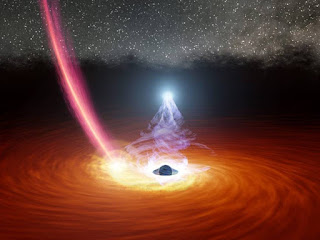Researchers have discovered three such supermassive black holes in the Universe, which are merging over time, the researchers believe, this event can lead to the formation of a triple active galactic nucleus. The new discovery has revealed that the compact region at the center of a galaxy, which is radiating a greater amount of luminosity than normal, means that there are no supermassive black holes.
Supermassive black holes are not observable, but we can detect them from clusters, when the surrounding dust and gas collapsed into the supermassive black hole, some of the mass was swallowed up by the supermassive black hole, and some of it as energy. It is converted into form, and is also emitted in the form of electromagnetic radiation, which makes the black hole appear very bright.
A team of researchers from the Indian Institute of Astrophysics including Jyoti Yadav, Moushumi Das and Sudhanshu Barve, along with François Combs from the Collge de France, Chre Galaxies et Cosmology, Paris, studied a pair of known interacting galaxies, NGC 7733 and NGC 7734. While studying, the team discovered that there is an unusual emission from the center of NGC7734 and a large, bright cluster along the northern arm of NGC7733. When the team of researchers examined the galaxy cluster NGC7733, they discovered that a small The Milky Way, which is moving at a different speed than NGC7733. This shows that the group is a small galaxy called NGC7733, its researchers named NGC7733N.
The study, published in the journal Astronomy and Astrophysics, used data from India’s first AstroSat space observatory, the European Integral Field Optical Telescope, called MUSE, the Very Large Telescope (VLT) and the Ultraviolet Imaging Telescope (UVIT).
The UV and H-alpha images also support the presence of a third galaxy, which could have been formed by the merger of NGC 7733N with a larger galaxy. According to the researchers, each galaxy harbors an active supermassive black hole at its core, forming a very rare triple AGN system.
The main reason for influencing the evolution of galaxies is the interaction of galaxies, this action occurs when two galaxies come close to each other, due to which there is a tremendous gravitational force in both of them. When two galaxies come close to each other, then the supermassive black holes of these two galaxies come close to each other, then there is a tremendous gravitational force. When the double black hole begins to consume gas from its surroundings, a double AGN is formed.
The IIA team says that when two galaxies collide, their black holes will also come closer, and transfer kinetic energy to the surrounding gas. As the distance between black holes decreases over time, it decreases until the separation is approximately one parsec (3.26 light years). When two black holes get even closer, they cannot lose much kinetic energy to merge.
The presence of a third black hole could solve this problem, DST says, that the two merging black holes can transfer their energy to the third black hole, and at the same time merge into each other. Researchers have detected several AGN pairs in the past, but triple AGNs are extremely rare for researchers, with only a few detected before using X-ray observations. The IIA team expects the latter, these triple AGN systems to be more common.






